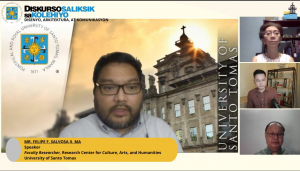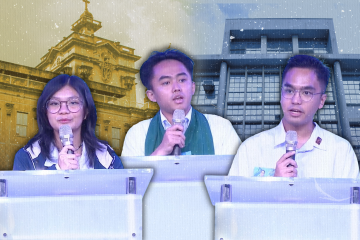by KAREN RENEE S. NOGOY and MATTHEW DAVE A. JUCOM

THE RELIANCE of journalists on government for information challenged the news coverage in the new normal, according to a study by UST journalism professors presented on Friday in a research conference.
The study “Reporting in the New Normal: The Impact of Covid-19 Pandemic on Journalism (Perspective from South and Southeast Asia)” by Felipe Salvosa II, journalism program coordinator, and Asst. Prof. Christian Esguerra in collaboration with Global Risk Journalism Hub found that among 175 respondents, the Philippines (91 percent) and India (87 percent) highly agreed that they depend on the government for information.
“We have been reduced to interviewing mostly via [online conferencing platforms]. If you watched the Malacañang press briefing, for instance, questions are limited when it comes to asking [the government] on-air [and] Malacañang could easily cut off the reporter,” Esguerra said.
This occurrence opened the need for media practitioners to ensure that the government would not control the narrative, he said.
Results also showed that reporters trusted medical experts and the World Health Organization for information, while also depending on press releases, scientific journals, and social media for information.
Media practitioners likewise seek to interview the marginalized sector for their perspectives to balance the information dissemination, the study revealed.
“While there was heavy dependence on government and experts [for information] about Covid-19, there is also an effort to get the side of the perspective on the experiences of marginalized sources,” Esguerra said.
Five countries in the South and Southeast Asian regions namely the Philippines, India, Malaysia, Thailand, and Nepal participated in the study.
Financial stress, publications closing down
Six out of 10 respondents feared that their organization would experience financial distress, the findings showed.
The journalism professors also said that in the Philippines alone, some publications were forced to shut down due to the aftermath of this pandemic.
“The effect of the pandemic has been the hardest on print media… We have seen community papers forced to close,” said Salvosa.
During the celebration of World Press Freedom Day on May 3, the SunStar Baguio, a community paper in the Northern Luzon region, ceased publication after a 30-year operation due to funding constraints and a decrease in revenues.
While these limitations occur on various news outlets, Esguerra urged various journalism schools to set more avenues for discussing the fundamentals of news media on varying platforms.
“Journalism schools can devote more lessons and subjects when it comes to the operation in the digital space, and how newsrooms operate under the new normal without forgetting the fundamentals which are all-encompassing as far as all the platforms are concerned in the news media,” he said.
Debate on research paper evaluation
Meanwhile, Media and Communication Studies researcher and author Asst. Prof. Maria Gwenetha Pusta resolved the ongoing debate on whether research paper evaluation should be data-driven or judgment-driven in her study, “A Research Policy Study on the Innovation, Technology, and Research in Designing a Communication Style Guide.”
“There is actually no one particular framework that can be applied considering the diversity of the communications discipline. Do we judge student research based on the data or do we apply certain criteria? To this end, the perennial question would be, ‘Who judges the student’s research, given the criteria set already in the study?’” Pusta said.
The study specifically addressed the blurring distinctions of what constitutes high-quality research communication practice in terms of credibility, contributory to scholarship, communicability, and conformity to acceptable.
She said that the specific criteria for evaluating the quality of research practice are “lacking” or “not well-defined.”
“The lack of widely acknowledged quality standards for research practice is somewhat surprising. A consequence of it is that judges of the quality of research—university boards, scholars, funding agencies, and journal reviewers apply the values and standards of their own minds, fields or discipline,” her research abstract wrote.
The expertise of communication researchers and teachers who evaluate student papers were considered in designing a communication style guide, she said.
“The findings of the study led to a very comprehensive manual with a communication style guide that is now being adopted by the department,” added Pusta.
The research conference “Diskurso Saliksik sa Kolehiyo 2: Disenyo, Arkitektura, at Komunikasyon 2” was spearheaded by the UST Research Center for Culture, Arts, and Humanities.
Faculty researchers from the College of Architecture and College of Fine Arts and Design also joined the conference. F



